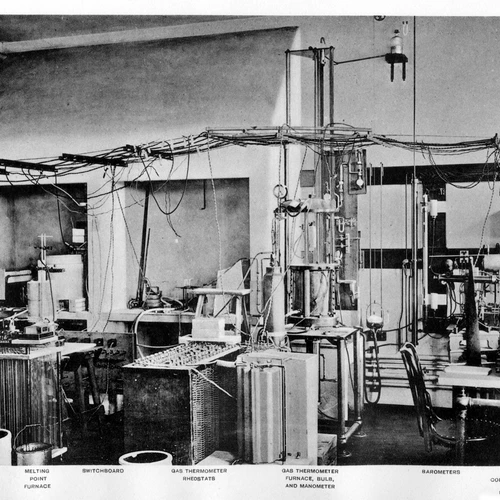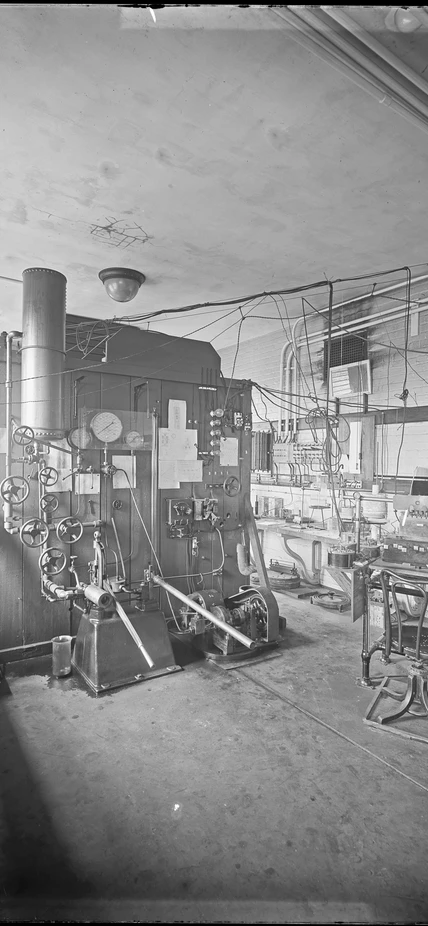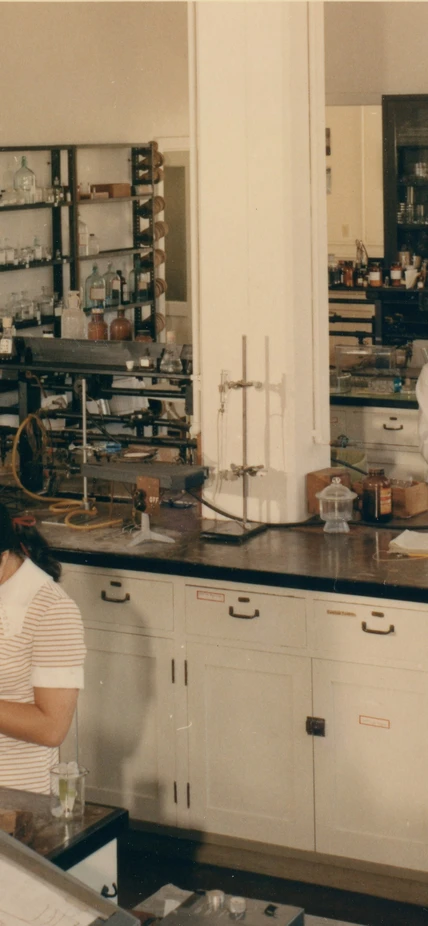Experimental petrology owes much to the foundation of the Geophysical Laboratory* in 1905 and later to the groundbreaking work of Norman L. Bowen in his classic 1928 book, The Evolution of the Igneous Rocks. While a respected area of geoscience research today, before the 1940s, according to science historian Carl-Henry Geschwind, the Laboratory and Bowen’s work were largely ignored or unappreciated.
*The Geophysical Laboratory is one of the founding departments that formed the Earth and Planets Laboratory in 2020.
The Laboratory was established at a time when top igneous petrologists wanted to gain “exact science” prestige for their field, like chemistry or physics. With the leadership and support of first director Arthur L. Day, the Geophysical Laboratory chose a more experimental basis for research over field study. The first experiments focused on discovering which phases of minerals or liquids are stable in a given chemical system while paying close attention to temperature and composition.

Starting at the simplest problems
Starting in 1909, the data for temperature-composition phase diagrams were attained by the quench method. To do so, a small amount of powdered material of known composition was heated to a known temperature and held there until the material reached chemical equilibrium. The sample was next quenched, which means it was quickly cooled to room temperature. This process freezes the higher-temperature phase relations so that they can be looked at and identified under a microscope.
For these experiments, the Laboratory concentrated on simple mixtures of only two or three components instead of natural magmas, which often contained eight to ten. As Day aptly put, “one must begin with the simplest problems, and then proceed in an orderly way to those more complicated-- first, the properties of single materials of the entire range of their stable existence; then combinations of two, in which both remain stable; then similar combinations in which exceptional phenomena occur; then simple rocks of three components, etc. – the general principle of effective progress being to meet and study the unknown phenomena one at a time.”
This reductionist approach to understanding the behavior of high-temperature silicate melts provided exactness to the Geophysical Laboratory’s work and aided the concerns of industries like cement, ceramics, and glass.
Bowen's illuminates igneous differentiation
A large step in improving the quality of the Laboratory’s work arrived in 1912 with Norman L. Bowen. His first studies were comparable to the work of others on phase equilibria in the Laboratory. Still, within a year, he began to produce experimental results on untouched materials and theories. His first papers pertained to his work with Olaf Anderson on clino-enstatite and the theoretical effects of forsterite resorption on magmatic differentiation.
Bowen set out in a new direction in 1914. He dedicated his work to prove that “the settling out from basic magma of certain minerals is the dominant control in the differentiation of most igneous rocks.” To accomplish this lofty goal, he used mainly physical experiments.
According to Bowen, experimentation and a thorough understanding of reaction relationships was key to comprehending magmatic differentiation. His most famous work, The Evolution of the Igneous Rocks, describes the many different routes magmas might take during differentiation by explaining experimental results from the Geophysical Laboratory.
Ingenious igneous insights ignored
Despite all the advancements in the Geophysical Laboratory’s work, Geschwind believes that throughout the 1920s and 30s, American igneous petrologists remained focused on analyzing naturally occurring rocks in field settings. Reductionist experimentation, to most igneous petrologists outside the Geophysical Laboratory, was not regarded as important as observation.
Another problem of the time was the lack of capital. There were insufficient funds available to duplicate the Geophysical Laboratory’s experiments outside the institution. However, there was financial support for geological surveys and field expeditions, and thus igneous petrologists persisted in their observations.
Field igneous petrologists considered the Geophysical Laboratory’s experiments too simple for their purposes. They also condemned the deficiency of volatile elements, like water, chlorine, and fluorine, in the Laboratory’s experiments. According to outside igneous petrologists, volatiles were essential to studying magmatic differentiation. Even Bowen’s work lacked volatiles.
To defend himself on this subject, Bowen stated that “volatiles are of little importance in the problem of igneous differentiation." He believed that less than one percent of natural magmas were volatiles. This amount was so small that phase relations determined from volatile-free systems would not be considerably affected. Despite these allegations, most petrologists remained skeptical.
As a whole, American petrologists disregarded the Geophysical Laboratory’s phase diagrams and Bowen’s theories and writings. By the early 1940s, the Geophysical Laboratory’s petrology program had yet to find widespread acceptance.
New director stresses collaboration, experimentation
This was all to change in the next two decades. Making the petrology program more accessible to the rest of the scientific community was one of the first items on Leason Herberling Adams'—director Day's successor— to-do list.
Unlike Day, Adams sought input from the Laboratory’s staff and outside petrologists. Adams also persuaded staff members to undertake geological field expeditions and laboratory investigations. These developments in communication made the Laboratory more receptive to field petrologists’ needs. Another change Adams put into effect was the object of study for Geophysical Laboratory petrologists. He stressed the importance of analyzing the under-pressure conditions of equilibrium between crystals and liquids in the presence of volatile components as well as nonvolatile. Adams also encouraged experimentation on natural rocks.
O. F. Tuttle’s work was instrumental in allowing for these experiments. He created a simple experimental set-up that allowed for the separate control and measurement of pressure and temperature. This practice greatly extended the available pressure and temperature range for experimentation, finally enabling a volatile-bearing system study.
Experimental petrology takes hold
Respect from outside petrologists was soon to follow. By the 1950s, American petrologists began to include phase equilibrium diagrams and experimental evidence in their papers. Bowen was a hero, and the Geophysical Laboratory was recognized as the cornerstone of petrological study.
At last, the Laboratory’s petrology had its niche.
-
Geschwind, Carl-Henry, Becoming interested in experiments: American igneous petrologists and the Geophysical Laboratory, 1905-1965, Earth Sciences History, 14 (no. 1), 47-61, 1995.
-
Yoder, Hatten S., Jr. Centennial History of the Carnegie Institution of Washington, Volume III, Cambridge University Press, Cambridge , 2004.
-
Yoder, H. S., Jr., Experimental mineralogy: achievements and prospects, Bulletin de Mineralogie, 103, 5-26, 1980.
-
Yoder, H. S., Jr., Timetable of petrology, Journal of Geological Education, 41, 447-489, 1993.
-
Bowen, N. L., The Evolution of the Igneous Rocks, Princeton University Press, 1928.
-
Yoder, H. S., Jr., Generation of Basaltic Magma, National Academy of Sciences, Washington, D.C., 1976.
-
Young, Davis A., Mind Over Magma: the Story of Igneous Petrology, Princeton University Press, Princeton, N.J., 2003.

